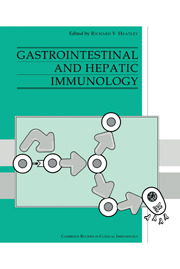Book contents
- Frontmatter
- Contents
- List of contributors
- Preface
- 1 Lymphoid cells and tissues of the gastrointestinal tract
- 2 Lymphocyte migration to the gut mucosa
- 3 Regulating factors affecting gut mucosal defence
- 4 Gastritis
- 5 The immunology of coeliac disease
- 6 Inflammatory bowel disease
- 7 Food intolerance and allergy
- 8 Gastrointestinal and liver involvement in primary immunodeficiency
- 9 Secondary immunodeficiency – the acquired immunodeficiency syndrome (AIDS)
- 10 Intestinal infections
- 11 Lymphomas
- 12 Small bowel transplantation
- 13 Clinical aspects of immunologically mediated intestinal diseases
- 14 Chronic active hepatitis
- 15 Primary biliary cirrhosis
- 16 Immunology and immunopathology of acute viral hepatitis
- 17 Immunology of liver transplantation
- 18 Clinical correlates with hepatic diseases
- Index
15 - Primary biliary cirrhosis
Published online by Cambridge University Press: 03 February 2010
- Frontmatter
- Contents
- List of contributors
- Preface
- 1 Lymphoid cells and tissues of the gastrointestinal tract
- 2 Lymphocyte migration to the gut mucosa
- 3 Regulating factors affecting gut mucosal defence
- 4 Gastritis
- 5 The immunology of coeliac disease
- 6 Inflammatory bowel disease
- 7 Food intolerance and allergy
- 8 Gastrointestinal and liver involvement in primary immunodeficiency
- 9 Secondary immunodeficiency – the acquired immunodeficiency syndrome (AIDS)
- 10 Intestinal infections
- 11 Lymphomas
- 12 Small bowel transplantation
- 13 Clinical aspects of immunologically mediated intestinal diseases
- 14 Chronic active hepatitis
- 15 Primary biliary cirrhosis
- 16 Immunology and immunopathology of acute viral hepatitis
- 17 Immunology of liver transplantation
- 18 Clinical correlates with hepatic diseases
- Index
Summary
Foreword
It would be improper to proceed with a chapter on primary biliary cirrhosis, without first reflecting upon a great contribution to the knowledge and understanding of the disease made by the late David R. Triger. Unfortunately, his premature and untimely death prevented him from writing this chapter. David Triger had a lifelong zest for the disease, its pathophysiology, clinical management and provided novel observations concerning its epidemiology.
Introduction
Primary biliary cirrhosis (PBC) is a disease of unknown aetiology associated with a variety of immunological disturbances which suggest a breakdown of immune tolerance. It is characterised by chronic infiltration in the liver and destruction of intrahepatic bile ducts and usually leads to cholestasis, portal hypertension, cirrhosis and death due to liver failure.
Incidence and geography
The disease has been reported from most parts of the world and appears to affect all ethnic populations studied. A study of the prevalence, incidence and death rates in various countries is presently being carried out under the direction of the International Association for the Study of the Liver. Provisional data suggest a marked variation across the world, which probably cannot be adequately explained by differences in clinical practice and diagnostic accuracy alone.
Many series have described incidence and prevalence of PBC in predominantly Caucasian populations. In the UK the incidence is reported to be 5–10/million/year and prevalence of approximately 25–50/million (Triger, 1980; Hamlyn, Macklon & James, 1983).
- Type
- Chapter
- Information
- Gastrointestinal and Hepatic Immunology , pp. 298 - 323Publisher: Cambridge University PressPrint publication year: 1994

